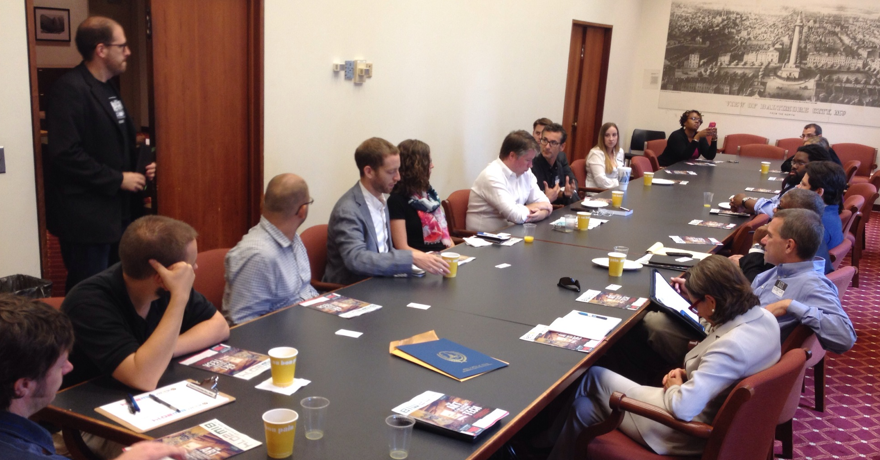When we go grocery shopping, most of us don’t buy a pallet of one product and survive on that for the rest of our lives. We get our food more regularly, so it’s fresher and more in tune with our tastes of the moment. So why wouldn’t education in the fast-changing STEM fields, look like that too?
That was how Andrew Coy, the executive director of the Digital Harbor Foundation, put it during an informal tech leaders roundtable discussion at City Hall Thursday morning.
The event, timed with the kickoff of Baltimore Innovation Week, was hosted by Technical.ly Baltimore and City Councilman Nick Mosby. The dozen leaders from different corners of the city’s nascent innovation economy were also joined by Council President Jack Young, incoming Baltimore Development Corp. Director Bill Cole, City Council Neighborhood Relations Director Damion Cooper, Baltimore Public Schools CIO K.J. Thompson and other council staffers.
The roundtable assessed where the Baltimore tech scene has grown and where it still needs to go.
Put broadly, the last decade has seen the foundation developed, but now the Baltimore tech community needs to connect with a wider swath of the region’s population, like forging relationships with the arts community and addressing workforce development for a city still struggling with poverty.
But pause and look what has changed.
Of the nearly 10 colocation and incubator spaces focused on IT and digital business development that have launched in Maryland in the last five years, seven are in Baltimore city, said Emerging Technology Centers Director Deb Tillett.
“We are developing that density,” she said, and a pedigree, too.
410 Labs founder Dave Troy got started young, building a tech business in the 1980s here, he said, and his civic commitment inspired Greg Cangialosi, who is now aiming to revive the once-sleepy ticketing agency MissionTix after his own exit.
Cangialosi, in turn, connected Mike Subelsky with his cofounder James Curran before they launched Staq, a small team building ad-sector software. McKeever Conwell, on his second startup, too, has cut his teeth following this previous class of entrepreneurs, he said.
When tiny businesses grow, they take up offices around town, something that neighborhood revitalization leaders like Ben Stone in artist-friendly Station North celebrate.
“I’m still trying to understand how we [the arts and tech scenes] can do more together,” he said.
Beyond just commercial real estate, connecting technologists can have wider impact — just look at a civic hacking movement, added Shea Frederick. By day, the software developer is improving ecommerce for apparel giant Under Armour, but in his free time, he’s using open data to visualize and better understand the city, like he did with Baltimore Vacants.
For now, though the impact of projects like his is small, since they’re not widely used yet, he said. But that can change as the work is shared with more people — and more local residents can build, learn and understand such projects.
Misty Melton, the founder of the Baltimore chapter of Girl Develop It, said her program is adding to the rolls more women who have basic dev chops.
To get there faster, “we need more formal support for informal learning,” said the Digital Harbor Foundation’s Coy, whose Tech Center offers learning opportunities in digital fabrication, coding and other STEM skills.
To reach 10,000 hours of mastery, a student would need 90-minutes every school day for 20 years. With after-school and summer support, a program like Coy’s could get that down to six years, he said.
How should a community as varied as tech bring together its varied priorities? Perhaps an updated and shared road map that puts into writing the various leadership efforts that groups are working on, said Andrew Rose, the Naden/Lean business development manager who announced he’s leaving the firm to lead Zest Social Media Solutions.
“It can be good to get our priorities together and know what we’re working to,” he said. We couldn’t agree more.
Join the conversation!
Find news, events, jobs and people who share your interests on Technical.ly's open community Slack

Baltimore daily roundup: B-360's policy moves; a foundation's fight for financial inclusion; Digital Navigator training

Baltimore daily roundup: Johns Hopkins dedicates The Pava Center; Q1's VC outlook; Cal Ripken inaugurates youth STEM center

Baltimore daily roundup: Scenes from an epic Sneaker Ball; Backpack Healthcare in Google AI accelerator; local tech figures' podcast


